We are amused in Fiji Museum Suva
A quick trip to the museum, this time by taxi, was called for on the Saturday before we left Suva. The first thing that stood out for us there was the giant sailing catamaran or waqa drua on show in the main hall that was built in Fulanga in 1913.

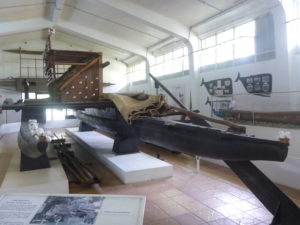
It was acquired by the museum in 1981 and the gentleman from Fulanga who assisted with the restoration and was the grandson of the original builder had the surname Cirimaitoga, the same as our hosts Mere and Jone on Fulanga, so they are from the boatbuilding heritage and that skill has been passed down to Jone in his carpenter skills.
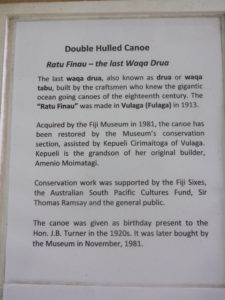
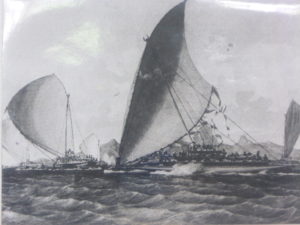

If you look at the little 1:10 model of the drua you will see the horned masthead (with the delightful name Domodomo) above the top of the sail. The ocean going canoes (which were often over 30 metres long) could be made to sail in the opposite direction without turning the vessel around. The mast would be brought upright so the sail foot would clear the deckhouse while it was being turned and then the mast would drop to the same angle as before but in the opposite direction. Clever eh! The Domodomos on those big babies alone could measure over 4 metres in height. I’d love to have sailed in one.
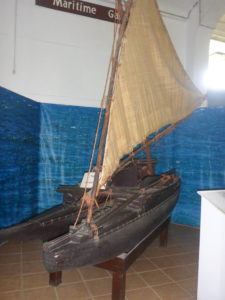
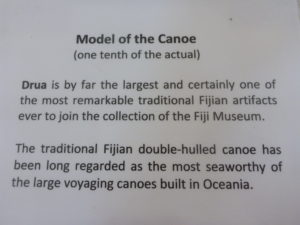
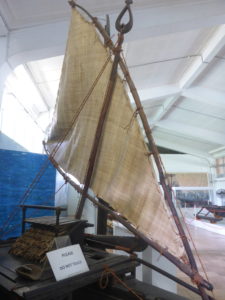
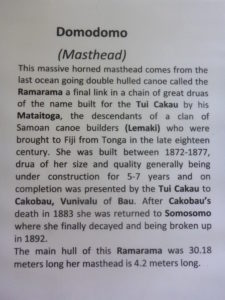
At the far end of the room were the remnants comprising the rudder of the Bounty, made infamous by her mutineering crew. I thought it a shame they could not display it upright but it would probably have fallen to pieces. The picture on canvas of the mutiny was fine by comparison.

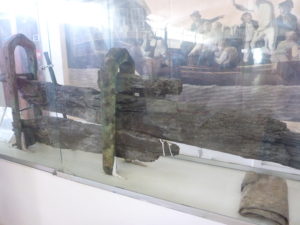

The bamboo raft you see is an example of the many still in use for bringing goods and crops from inland farms, down the rivers to the markets in Savusavu and Suva on both the big islands and are also used for local fishing near the villages. We saw them when we visited that little village near the waterfall in Vanua Levu if you remember.

From one beautiful item (the drua) to another in the form of a wedding dress made from masi matting. The dressmakers must have worked the fabric to soften it from its starchy natural texture into this lovely creation worn in 1991 when a local lass, Ada Litia Mara married Mr Henry Dugdale.

Finally a tale of murder and cannibalism. In 1867 Methodist Missionary Rev. Thomas Baker (shown in the photo), along with a Fijian convert and six student teachers were murdered and eaten while they were working in central Viti Levi. This is the only case of a European minister being cannibalised despite the fact Christianity was threatening the traditional Fijian religion and causing disquiet amongst the chiefs. Usually it was Fijian Christian converts who were murdered. Ironically it was a Christian chief who ordered the murder because the minister held a meeting at an alternative location to the one offered by the chief. Confused? Me too. Anyway there’s the bowl and fork supposedly used for the feast.

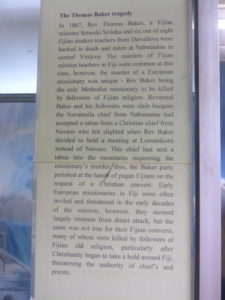
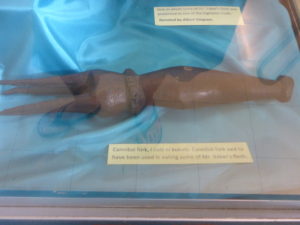
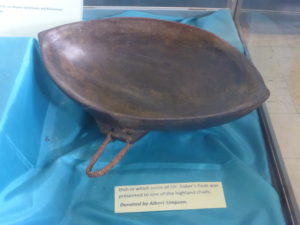
After all that culture and a delicious iced mocha in the café overlooking the gardens, we wandered back through the same and I have added the picture of the tree because it is a fig tree, or Bodhi Tree and it is under the embracing branches of the like that Buddha received his ‘Enlightenment’ 500 years BC., The Tree of Knowledge.

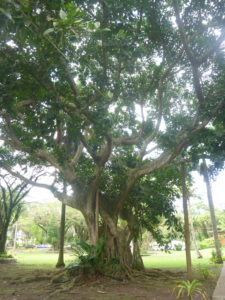
Before departing from the convenience of onboard internet I made arrangements for Zoonie’s berthing for the cyclone season back in New Zealand and started the ball rolling for our flights home via Australia. The earlier the better we reasoned and we were right.
Spaces are filling up quickly in Port Whangarei where she will sit on the hard for four months after a few weeks in the Town Basin to complete the small but growing list of jobs and to catch up with friends. This afternoon (14th Sept) I added Rutland Wind generator to the list as it has started making damaging “My bearings are wearing” noises in the strong winds we are presently riding out. So we put a sock on it so to speak and it is off duty now until we can fix it.
Two days after Christmas to be spent with our dear friends Jeannie and Merv, we fly to Sydney hopefully to see Alison and Randall, Jane and Greg and maybe even Peter and Martina while we take a look at the big cities in the south east before jumping on the Ghan Train to Darwin from Adelaide via Alice Springs and then flying from there to London, via Sydney again, on the 28th/29th January. But in the meantime there’s the rest of our stay in Fiji to enjoy!
Sunbeds and Sevusevu at Draveuni Island in the Great Astrolabe Reef
With a light wind on the nose Zoonie was yet again under motor to her destination. The Herald Passage was nice and clear in deep blue water with the reefs marking the passage on each side of us. The charted depths for Astrolabe reef are generous, twenty to thirty plus metres but we still exercised caution with Rob in the bow once more as lookout.
The reef is named after the French exploration ship which nearly foundered here under the command of D’Urville and indeed the area is littered with the sunken wrecks of small ships and yachts, so we were forewarned.
We were heading towards Draveuni where we needed to do our Sevusevu before we could explore any of the islands. The village off which Zoonie was anchored was very quiet. All the school age children were within the fenced school compound sitting at their desks. A middle aged man pointed to a young lady washing up outside her home.
She greeted us with a smile and words of welcome and invited us into her house. “I will call dad to come.”
I’m not sure if he was the chief or a stand in but he bade us sit and then looked around us to see Rob had the kava, “So you have brought kava,” he prompted and Rob handed it to him. A few Fijian words of welcome were followed by the first of numerous yawns. This guy was not into small talk. We attempted making some conversation but the frequency of the yawns suggested the time had come for us to leave. “Is it alright if we walk up the hill?” He waved an arm and suggested we do that.
A cruise ship comes every few weeks and spews passengers ashore for a Fijian massage at $20 a time. All along the frontage of the village are wooden massage beds, grouped in fours with little grass roofs, so this chief is used to much bigger and more lucrative fry than us. He could take a lesson in friendliness from the little girls who called “Bula” and waved at us from the doorway of their village home.
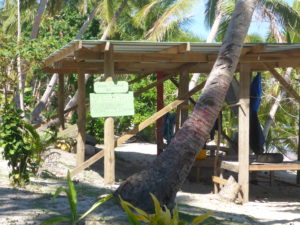


The path led through the village, past small areas of planted crops and penned pigs and up a soil track to the 113 metre summit from which we could see north to Suva, all around the barrier reef of the Astrolabe (the fourth largest in the world) and south over Ono Island and Kadavu beyond. We had the perfect day for it as the photos will testify.
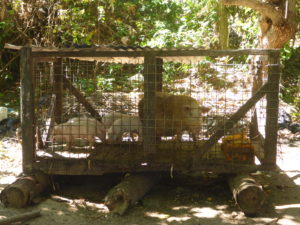
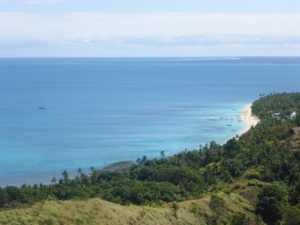
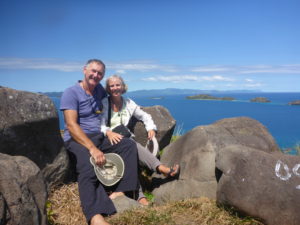
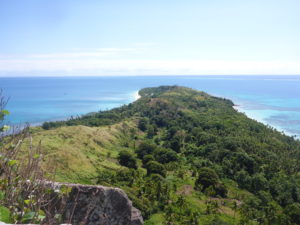
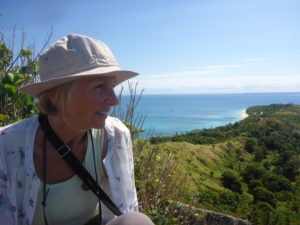

There was a wind coming in the forecast which would typically last for a few days. Ideal if on passage but as we weren’t we needed better shelter than this little beach could offer. Two deep natural harbours facing north and west looked like good options in the E/SE’lies that were due so we moved on to Yaukuve Levu now better known as Kokomo Yaukuve Island Resort for possibly just an overnight stop on route.
One thing the ‘chief’ did tell us was that he owned 7 of the nearby islands including one, and I think it was Namara, on which the current Swedish Survivor season was being filmed. He told us to keep clear of that island which lies just to the west of where we were.
But Yaukuve Levu is owned by the Fiji Development Bank and is under lease to Lang Walker, a multi billionaire property developer from Australia, Australia’s 17th wealthiest man. For over 50 years he has worked hard at his business but developing this island into the Kokomo 5 star resort has been a passion project of his aside from his regular business and has proved to be the toughest project yet.
Wading through Fiji’s snail pace bureaucracy, the remoteness of the island and the cultural differences are all hurdles that Lang and his team have patiently overcome.
One highly visual difference between Lang’s philosophy and that of say Dietrich Mateschitz of the Laucala resort we passed a few weeks back that bans anchoring anywhere nearby is Lang’s openness. We had heard that this was a friendly resort and within minutes of Zoonie’s anchor gripping the sea-bed a man in a rib came bouncing out to us and said we were welcome to go ashore anytime and visit the resort if we could just follow him first to a different anchor spot as we were blocking the view from the Walker D’Plank (get the pun on Lang Walker?) Beach Bar.
We had set Zoonie in this spot as it gave us some shelter from the wind belting around the end of the island. Our new spot was directly in line with the wind but never mind, anything to oblige.
A few minutes later Rebekah arrived with her boatman. She is from Auckland and no doubt did her hospitality training in university there, “Please come and visit us just for a look around or a drink. You are welcome to dine in one of the restaurants for $75 per person not including drinks. The seaplane is due at 2.30 so maybe come before or after it has left.” Well of course her motives were partly commercial but you don’t go into that industry if you don’t enjoy people do you? I liked the way she was upfront about the cost of dinner too. We dusted off our visa card in readiness, “That’s right we don’t take cash”!!
So while waiting for the arrival of the seaplane, camera switched on in readiness, Rob and I came up with as many reasons as we could to celebrate and justify the coming gastronomic experience. Henry starting Middle School, my Birthday, (although we might have already celebrated that once, at my age it pays to make sure) our coming 9th Wedding Anniversary (quite an achievement as I’ve never got beyond 7 years before), the recent wedding of Rob’s youngest nephew James and Emma in Brighton; we thought that would do and made our way ashore to book and snoop around after deciding the seaplane wasn’t going to come probably due to the rising wind forecast.
We tied up the tender on the inside of the seaplane jetty and immediately came face to face with the sort of pilot fish that stick the flat sucker area on their heads onto the underside of sharks so they can feed on scraps discarded from the shark’s mouth. They were all around us in the perfectly clear water, I’d never seen them so close before.
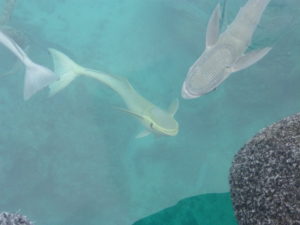
Casually uniformed staff came down the jetty towards us all “Bulas” and hand- shakes, very friendly bunch. Henry met us and invited us into the reception area in the massive but modestly named Beach Shack. I asked him if he had a brochure of the Resort and while he disappeared to find one we absorbed the décor of high ceiling lined with pandanus matting, the chunky cinnamon wood supporting pillars came from Mel Gibson’s nearby island of Mago, the globular grass lampshades and shell mobile and the comfy settees and coffee tables with resort magazines in wicker baskets. H’mm this would do for our celebration.
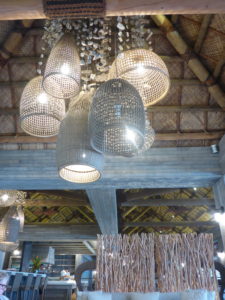
Henry returned with a brochure and booked us in and then we decided on a wander around. A little flotilla of golf carts stood ready by the main door and Loqo asked if we would like a ride around the resort with him. The seat at the back was covered in a smooth shiny fabric and Loqo was a potential formula one driver in disguise, so we clung tight to the handrail and eachother hoping we wouldn’t be shed into the road as he accelerated.
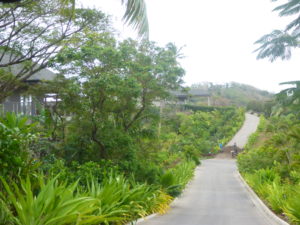
Building started here around 7 years ago and the plan was for just a few luxury beachfront villas but now there are 21 and most of the central area of the island is taken up with them on both sides; a Pacific view or a Kadavu Passage view. A further five secluded private homes are also available and the resort can now host 140 guests at between £1540 and £14000 (for Lang’s own home) per night or thereabouts. Like me Lang does believe in price negotiation!
There is also a vegetable garden complete with beehives. The project is constantly changing with guests enjoying and witnessing an ‘adaptive experience’ as Lang likes to put it. Local ladies will bring along a basket of some vegetable or fish they have cut or caught, for example little garfish or pipefish, and the resident chef, Caroline Oakley, a local Fijian lady and her team of three other local ladies will use them that day on the ever evolving menu.
After our tour we sat in a lounge area and watched young men laying cut grass along the front roof of the restaurant as a kind of aesthetic thatch. A young lady brought us some iced tea but we declined the cakes as we were saving our appetites. It was looking very grey and windy outside when we heard the helicopter land on its pad just up the hill. A couple were whisked to the covered entrance in a buggy where a group of the Fijian staff were ready with tuned voices and guitars to give an exotic welcome to the new guests. I just hoped the weather would improve for their stay. There was time between then and dinner to return to Zoonie and relax.
Lesle was our charming waitress giving us a full explanation of each course and asking permission to remove this and pour that. I liked the way most of the staff were locals, their natural open friendliness enhancing their work performance. You will see the menu and some of the dishes. One of my favourites was the pecan nut in honey from bees lovingly tended by the executive chef, Australian Anthony Healy who shipped twelve hives and colonies to the island on what has become his passion project.


I thought of the locals earning money from providing the lobster for the bisque and my roasted bream with the crunchy top. Then we both enjoyed the papaya sorbet and chocolate mocha in a mini glass fishbowl. I noticed a gap at the far end of the dining room verandah roof where the grass thatch laying was still in progress. More about that later.
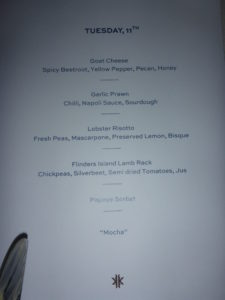
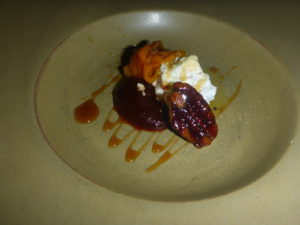
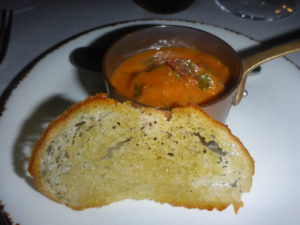

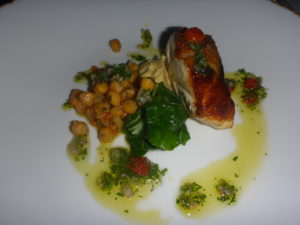
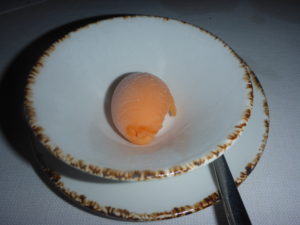
We lingered over the tasty sav blanc before bracing ourselves for a wet ride back, but not before I spotted a rare phenomenon of the tromp d’oeil kind suspended in the water and lit by the white light underneath the pontoon.
Alison would have been as thrilled and mystified as me, or rather she would probably have identified them straightaway as juvenile spadefish or batfish. It took me 2 days of internet searching.
What confused me, but not Rob, was that the white light from the pontoon lights made the whitish stripes on the fish disappear so all I saw was black shapes a little like a sundial without its base and with flat side fins. Also the five fish were totally still like black leaves. Wonderful but a missed photo I’m afraid.
I thank the Australian Financial Review website and the Virgin Australia Publication for many of the facts I have just written.
During the night a wind of Churchillian proportions blustered around the end of the island with wit and gusto, one minute determined to pluck Zoonie’s anchor from its grip and the next leaving her wallowing in a vacuum of no air, not so witty for us.
At first light I was motoring Zoonie ahead as slowly as the control lever would allow while Rob worked the windlass up on the bow. My concern, you see, was the very large, modern and valuable yacht just behind us that it would be a shame to damage! “Anchors free,” Rob called. He cannot always tell when the anchor breaks from the seabed and usually it doesn’t matter if we drift back a little once it is on the rise, but today it did matter!
We passed the island where some Swedish celebs were freezing their little butts off in the chilly wind and slipped around the headland two hours later into the natural harbour on Ono Island to shelter from the continuing few days of blow. Nabouwalu Village faced us at the head of the harbour.
As soon as we were secure, near a yellow cat and a white sloop, I was standing in the cockpit when I saw something large and soft roll down a vertical grassed limestone cliff to the beach below. In a field above three men were cutting grass. Ahah I thought.
A few minutes later we watched a panga, or should I say a load of grass with a panga just visible underneath it, pass us and it wasn’t until it was well past that we saw the driver. “I bet I know where that is going Rob”.

“I don’t rate his chances getting all that around to Kokomo in this wind” Rob half joked. When Lang started his passion project he employed most of the young men on the islands to do the work. He worked on a pay (them) as you go basis. However, being Fijian they often, once paid then went, not turning up the next day for work. So then he introduced a ‘pay once the villa is complete’ basis and that worked better.


Mike, the chief here in Nabouwalu Village confirmed that most of the young men have found useful work thanks to Lang’s project resort. While we chatted his wife was weaving coloured wool around the edge of a new pandanus mat for a wedding present for one of their two daughters. They also have two sons.

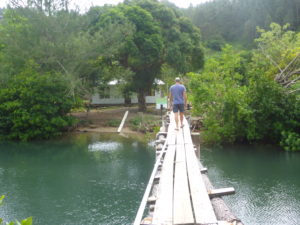
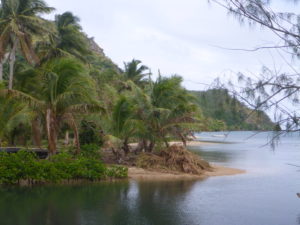
His wife asked if we had some school equipment like pencils, pens for the older children and reading books. Also she was in need of food containers and bottles with lids as they have a problem with rats and cockroaches. I asked if they had cats to see off the rats, she screwed up her nose, “We cannot have cats and free range chickens!” I guess not, but they had plenty of free range skinny dogs.
The school children were due back from their weekly boarding school tomorrow at 4.00pm by panga. Two very young children stood at the doorway, their big round eyes studying us. Both said shy “Bulas” when their grandpa coaxed them.
Mike’s wife said they had plenty of water (presumably as a river runs alongside the village) and we were welcome to help ourselves. We wandered along the village paths, all bordered with colourful bushes and noted the profusion of outdoor showers. Some new homes were under construction with imported planed wood and thin tin walls. The buildings were raised well off the ground and had verandas all around, but work had stopped on them and I wondered who they were for.
Matthew was just coming out of his front door and noting the limp and thick bandage on his leg I instinctively said, “So how is your leg today?”
“Better than it was, thanks” He cut it with his machete while harvesting either grass or sugar cane and was taken to Kadavu Medical Centre where they fixed him up. “I could see my leg bone” he confessed with alarm. We chatted and it transpired his sister, Salome, is living with her soldier husband in the army barracks in Marchwood near Southampton! Small world.
Well that was three days ago and we are nearly up to date with this blog. We are still at anchor here as the wind howls and the rain pours. The poor school children got a drenching as they sped past heading for home in their panga on Friday. The cuddy was not big enough for all of them.
We plan to go ashore tomorrow, Monday (don’t often use the future tense do I?) and deliver writing things and bottles and plastic punnets to the chief’s wife, and I must write down her name this time. There is a walk over the hill we would like to take if it’s not too slippery after the rain and then we’ll be thinking of moving on.
The problem we have at the moment is lack of trustworthy waypoints to help us explore Kadavu Island. You may wonder why I spell names in various ways, sometimes I spell the way it is said with an ‘n’ and other times as it is written, both are used and correct.
Remember when we went to Curly’s Seminar in Savusavu he told us to email him as and when we needed waypoints for anywhere in Fiji. Well his response to my email was to say that the hard drive of the computer on which he has all his waypoints lists crashed so he cannot help the 39 cruisers who signed up with him this year. Backups Curly?!
The Lost Island of Burotu in the southern waters of Fiji
You may recall, dear reader, a few blogs ago I mentioned a lost island which I read about and we discussed with Chico the chief of Lomaji, one of the seven villages in Matuku, while we stayed there for a short time.
The name Matuku is relatively recent and before it was introduced by migrants from Vitilevu the island was called Burotukula or Burotu.
The name Burotu has become synonymous with ‘paradise’ a place of luxuriant vegetation and wildlife and beautiful women. As far as the flora and fauna is concerned this was true of many Fijian islands before the arrival of Europeans and in the early days of human habitation when the birdlife was prolific. Many of the woman are beautiful today, by the way.
The English, in particular daughter Emily, value diamonds, the Incas and Aztecs valued gold, the Chinese value Jade and the Fijians value ‘kula’ and one of the meanings of kula is deep rich red, or crimson. Note the kula ending of the original name of Matuku, Burotukula.
The original Fijians used to border their pandanus sleeping mats and formal clothing with kula, the bright red feathers of the musk parrot and the collared lory, one of the birds we had seen on our Sunday bird spotting tour with Alison and Randall in Savusavu. These red feathers became a major trading item between Tonga and Samoa and Fiji because the birds are not found in the first two island groups.
This is why they became extinct on some Fijian Islands and forced the Polynesian traders on to Matuku where they can still be found. For centuries the island was the centre of the trade in kula feathers until the increasing value and declining supply led to a war after which some Matukuns fled to Samoa and Tonga.
Imagine their arrival, decked out in warrior clothing bordered with these beautiful feathers, they would have appeared as the messengers of the Gods and they set up ruling families in Tonga and Samoa maintaining their status to this day. It is still believed that the souls of the chiefs of Tonga and Samoa return to distant Burotu in the west. As we have found before, letters in words get changed between languages and to the Polynesians Bulotu is referred to as Pulotu.
But what of the theory that Burotu was an island that disappeared and occasionally reappears, sometimes after a long kava session (!) The volcano at the summit of which lies Matuku, is very big and there is a submarine platform that shows up using sophisticated echo imagery around ten miles down its south western side. From Zoonie there was no evidence as we sailed past, which is not surprising as it lies just short of 2000 metres below the surface, which makes its occasional reappearance more of a legend than a likelihood.
Having said that there is a stone causeway that leads in the direction of the sunken island from the south west of Matuku and it brings to mind a road on the north coast of the Isla of Wight, where I once lived, that appears to go straight into the Solent, the stretch of water between the Isle and the mainland.
It was once a Roman road that crossed over a packhorse bridge astride the Solent River, and it emerges up a track on the other side near Lepe. In the last two thousand years the water level has risen making the roadway and bridge unusable. So the causeway of Matuku must have led to some significant place and at that time both the island and the place at the end of the causeway would have come under the same name of Bulotu.
But we like such stories don’t we? Loch Ness Monster, Camelot, and Atlantis and in some of them there are elements of truth. Since all land is sinking through tectonic movement and erosion the slipping down of this island is quite likely. The location of the platform is 19*18’S and 179*34’E.
Most of the historical and oral evidence suggests that these warriors arrived in Tonga and Samoa around 1000 years ago at the start of oral tradition recollections. Woman living in the two villages to the south west of Matuku, Makadru and Levukaidaku are still able to teach the unique ‘meke’ or dances from Burotu, as they have themselves been taught by their mothers before them, and they claim that when Burotu reappears it does so in the passage through the reef near them named Davetaidaku, although this a long way from the submarine platform favoured for the lost island’s location.
Fortunately for the red feathered birds the arrival of Europeans brought brightly coloured wool which replaced the diminishing supply of feathers and who knows, maybe some of the parrots and corys whose song filled the air around Zoonie in her anchorage are descendants of their Burotu ancestors.
I like myths and legends not only for the fun of trying to find what is true and what is made up but also for the questions that are left unanswered and hopefully always will be thus preserving the mystery.
Bogi Ono Cagi, The Six night wind on Ono Island
Last night (Tuesday 26th September) here in Nubululekaleka Bay, (18:06.53S 178:23.71E) just a few miles from the city of Suva on the main island Viti Levu we and a handful of other cruising yachts some on buoys and others like us at anchor experienced a humdinger of a thunder storm.
We are in this little protected bay on a nice secure mud bottom but when the wind shot into the bay and bent all around it so yachts instead of moving like a group of young synchronised swimmers, started veering helter skelter and we came close to one, fortunately occupied, so we could exchange niceties like “Hello, are you dragging?”
“No I think we’re ok are you alright?” Then his wife shrieked “Oh God there’s lightning” and dashed below, maybe for the fire extinguisher?
So when it eases off a little today we may move a little further away from them. We are here until this blow moves on. It is caused by a high to the east not allowing a massive low to move across, so we are just sitting taking all the rain and wind it has to offer. When we arrived two days ago the water was quite clean but now it looks like a café latte and with Suva City hidden in the rain we could be back in the upper reaches of the Ecuadorian Amazon. But I digress so back to the story.
As I mentioned in the last blog we secured Zoonie in a little Bay on Ono Island in the Astrolabe Reef ready for the six night blow. What a nice coincidence that the name of the island, Ono, means six in Fijian. A couple of pangas, looking like floating hedges, still braved the elements to deliver their loads of reed to Kokomo. One panga came from the village around the corner and asked if we had an epoxy glass repair kit and we had to tell him we had given our only one to Chico on Matuku Island.

As soon as the weather cleared we went back to the village to deliver the items requested by the chief’s wife and included our old solar panel which might be of use to them. Two more ladies joined the group, a young lass possibly the chief’s daughter and an older lady who retired back to the island after a career of teaching in Suva. We had a nice chat about how she prefers her life here and did not like Suva, while sipping lemon tea made with a single lemon rind peeling in a mug of hot water and nibbling baked sliced plantain (like fat bananas).
They gave us six nice green plantains as a parting gift and we wandered back through this pretty village, with its numerous mother chickens and their little broods clucking around the colourful bushes, then across crab city with its hundreds of burrow residences, over the rickety bridge across the little bayou and back to Zoonie.

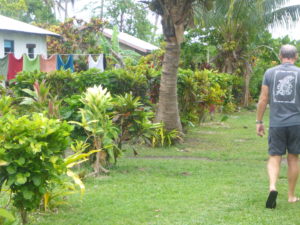
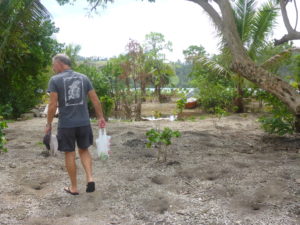

In the afternoon we snorkelled. There were some wonderful really big clams like the ones that used to be common in these waters and little seasnakes lurked at the entrance to their burrows, clearly watching us as we floated above. The weather was improving and after our prolonged stay here we were ready to move.
We anchored off Kokomo again for a snorkel. We had been discussing the idea of taking Zoonie out to the barrier reef where there were two nice anchorage areas over sand shown on the charts, but when the day dawned it was grey and dull so we decided on a known and friendly spot and launched ourselves into the clear water near the resort.
It was our ninth wedding anniversary and we had a treat in store. Relaxing in the cockpit, post snorkel cup of hot chocolate in hands, we heard the familiar drone of the seaplane engines as it approached with the latest group of guests.
As you know, dear reader, I love anything like that, so we sat excitedly anticipating its arrival. Well you can see from the photos we were not disappointed, in fact the pilot decided by coincidence or design to land straight towards us and an hour or so later to take off between us and the island, just brilliant. I was so happy I sent the photos to Rebekah yesterday and asked if the pilot had intended to buzz us and she replied that she has sent the photos on to all their pilots to find out. If I hear back I’ll let you know.
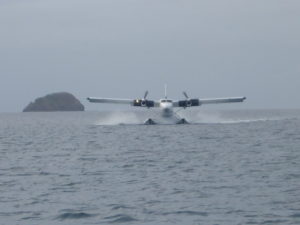
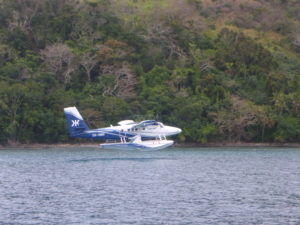
The next day dawned grey again so our trip to the barrier reef was off and instead we motored the 30 or so miles to Beqa Lagoon in 32’ temperature and 70% humidity anchoring off another pretty resort in Malumu Bay. On route we had hosed water via the kitchen tap from the watermaker port tank into the starboard tank while making water to replace it so we were nice and full on arrival.
La La was doing some paperwork behind the bar when we went to see if there was any cold beer on offer. “We are closed now, some more people coming next week but I can do a happy hour and beer for you tomorrow?” She said with a lovely big beam.
“That’s really kind of you but please don’t open up just for us.”
So we stayed in that lovely spot for just one night, with friendly locals waving as they passed or like the lady in the photo, stood waist deep fishing for their supper. The sound of cicadas filled the air evening and morning with the local birds trying very hard to be heard above the cacophony.


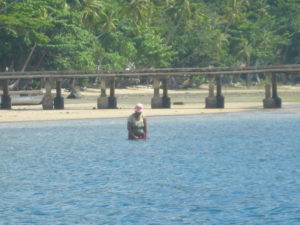
The next morning after the pink sky faded to blue, we motored around Beqa Island with the hope of finding another resort where we might be able to join a group going out to the barrier reef for a snorkel. But it seems that the surf and dive centres are no longer and all that activity is now run from Pacific Harbour on the mainland. Many dive boats come out and spend a few hours on the reefs never going near the islands. I guess it makes sense if you are flying in on a package holiday to leave for the island from your hotel on the mainland, but once upon a time there were local businesses that must have picked up passing trade and direct bookings by phone.
Yanuca Island has a lovely little bay on the north-west side so Zoonie’s hook sped down through the clear blue water and lodged nicely into a patch of white sand amongst the coral and rocks. Ashore we spoke to the man of the resident family who waved a hand towards a substantial building of which at least half the floor area was outdoor with just a roof and low walls and referred to it as his home. Clearly it has morphed into his home and the chalets nearby were no longer in use.
“There is a centre just around the headland” he advised, so we took a trip around there in the tender and found a neat little resort with a group of youngsters playing volleyball. A charming local invited us to sit in the communal building for a chat. The resort is now owned by a local from the village and provides accommodation only. When we asked about snorkelling out at the reef he said the bay we were in was fine snorkelling. Out at the barrier reef the popular sport is reef surfing, again with punters arriving from Pacific Harbour by boat.
So we had a good look at the abundance of soft corals that floated like mini trees in the clear waters. They survive storms better than hard rigid corals and will set about restoring a damaged area in a process called ‘phase shift’ which transforms the seabed into predominantly soft corals that help maintain the fish feeding area until the hard corals regrow.
